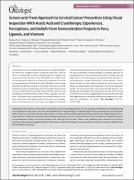| dc.contributor.author | Proma, Paul | |
| dc.contributor.author | Winkler, Jennifer L. | |
| dc.contributor.author | Bartolini, Rosario M. | |
| dc.contributor.author | Penny, Mary E. | |
| dc.contributor.author | Huong, Trinh Thu | |
| dc.contributor.author | Nga, Le Thi | |
| dc.contributor.author | Kumakech, Edward | |
| dc.contributor.author | Mugisha, Emmanuel | |
| dc.contributor.author | Jeronimo, Jose | |
| dc.date.accessioned | 2020-11-12T07:37:12Z | |
| dc.date.available | 2020-11-12T07:37:12Z | |
| dc.date.issued | 2013 | |
| dc.identifier.citation | Paul, P., Winkler, J. L., Bartolini, R. M., Penny, M. E., Huong, T. T., Nga, L. T., ... & Jeronimo, J. (2013). Screen-and-treat approach to cervical cancer prevention using visual inspection with acetic acid and cryotherapy: experiences, perceptions, and beliefs from demonstration projects in Peru, Uganda, and Vietnam. The oncologist, 18(12), 1278. | en_US |
| dc.identifier.uri | https://hdl.handle.net/123456789/202 | |
| dc.description.abstract | Cervical cancer is preventable but continues to cause the deaths
of more than 270,000 women worldwide each year, most of
them in developing countries where programs to detect and
treat precancerous lesions are not affordable or available. Studies
have demonstrated that screening by visual inspection of the
cervix using acetic acid (VIA) is a simple, affordable, and sensitive
test that can identify precancerous changes of the cervix so that
treatment such as cryotherapy can be provided. Government
partners implemented screening and treatment using VIA and
cryotherapy at demonstration sites in Peru, Uganda, and Vietnam.
Evaluations were conducted in the three countries to explore
the barriers and facilitating factors for the use of services
and for incorporation of screen-and-treat programs using VIA
andcryotherapyintoroutineservices.Resultsshowedthatuseof
VIA and cryotherapy in these settings is a feasible approach to
providing cervical cancer prevention services. Activities that can
help ensure successful programs include mobilizing and educating
communities, organizing services to meet women’s schedules
and needs, and strengthening systems to track clients for
follow-up. Sustainability also depends on having an adequate
number of trained providers and reducing staff turnover. Althoughsomechallengeswerefoundacrossallsites,
othersvaried
fromcountryto country, suggesting that carefulassessmentsbefore
beginning new secondary prevention programs will optimize
the probability of success. The Oncologist 2013;18:
1278–1284 | en_US |
| dc.language.iso | en | en_US |
| dc.publisher | The oncologist | en_US |
| dc.subject | Cervical Cancer Prevention | en_US |
| dc.subject | Acetic Acid and Cryotherapy | en_US |
| dc.title | Screen-and-Treat Approach to Cervical Cancer Prevention Using Visual Inspection With Acetic Acid and Cryotherapy: Experiences, Perceptions, and Beliefs From Demonstration Projects in Peru, Uganda, and Vietnam | en_US |
| dc.type | Article | en_US |

